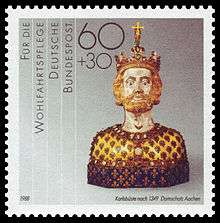Bust of Charlemagne


The Bust of Charlemagne (de: Karlsbüste) is a reliquary in the form of the bust of Charlemagne made around 1350, which contains the king's skullcap. The reliquary is part of the Late Medieval treasure kept in the Aachen Cathedral Treasury. The bust is one of the most significant examples of Gothic goldwork and the best-known example of a reliquary bust anywhere. The reliquary is an idealised image, not an actual portrait of Charlemagne.
Description and art historical significance
The reliquary bust is chased with silver and is partially gilt. It depicts the bust of Charlemagne, with a bejeweled, golden lily crown. The hair and beard are gilt, the face and neck worked in chased silver with accentuated modelling. Damascened silver eagles decorate his breast - the Reichsadler as heraldic charge of the Holy Roman Empire signifies the imperial dignity of Charlemagne. The eagles are surrounded by a border of Filigree and precious stones, some of which are ancient intaglios. The bust stands on an octagonal pedestal equipped with an opening on either side for a wooden carrying frame and is decorated with Fleurs-de-lis which support the bust's origin as a gift of Emperor Charles IV who had been raised in France.
The Bust of Charlemagne, as a masterpiece of Mosan goldwork, initiated a golden age of silver gilt naturalistic reliquary busts.[1]
History
According to the Aachen tradition, the Bust of Charlemagne was a donation from Charles IV, who was crowned king in Aachen Cathedral on 25 July 1349. This donation is not mentioned in documentary evidence, but it is considered probable, given Charles IV's deep veneration for Charlemagne. The reliquary is a part of the thirteenth-century French tradition of royal images and depicts an idealised portrait of the Frankish King, although it also has some rather individualised features. These are noticeably similar to a portrait of King John II of France. It is possible that the creater of the reliquary bust, a goldsmith in Aachen, had been trained in his art in France. The reliquary was carried in processions and placed opposite the king at coronations, who was spiritually affirmed in this way as a legitimate successor of Charlemagne. The use of ancient intaglios and cameos on the reliquary indicates the special significance of Ancient Rome to the Medieval imperial ideology - both Charlemagne and Charles IV saw their rule as part of that tradition.
Recent historical research holds that it is very probable that Charles IV was crowned with the same crown which is worn by the reliquary - since the Imperial Crown was then in the possession of Charles' rival Louis IV. It is probable that the hoop with its cross was added on the occasion of his coronation. Sigismund of Luxemburg was crowned with the same crown in 1414. A parallel to this crown is seen in the Crown of Saint Wenceslas in Prague, which decorated the reliquary containing the skullcap of St. Wenceslas and was used at Charles IV's coronation as King of Bohemia in 1347.
Symbolic significance and use
On account of its wide recognition value for the City of Aachen and its idological and artistic significance, a stylised version of the Bust of Charlemagne serves as the central element in the signet of the Foundation of the International Charlemagne Prize of Aachen
Bibliography
- Birgitta Falk. Bildnisreliquiare. Zur Entstehung und Entwicklung der metallenen Kopf-, Büsten- und Halbfigurenreliquiare im Mittelalter. In Aachener Kunstblätter 59, 1991–93, pp. 99–238.
- Herta Lepie, Georg Minkenberg. Die Schatzkammer des Aachener Domes. Brimberg, Aachen 1995, ISBN 3-923773-16-1, p. 27.
References
- ↑ Klaus Gereon Beuckers: Der Essener Marsusschrein. Aschendorff, Münster 2006, ISBN 3-402-06251-8, p. 30.
External links
| Wikimedia Commons has media related to Karlsbüste. |